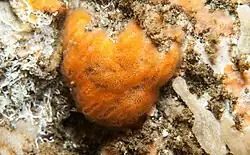Celleporidae
| Celleporidae Temporal range:
| |
|---|---|

| |
| Cellepora pumicosa photographed at Sula Sgeir, Scotland | |
| Scientific classification | |
| Kingdom: | Animalia |
| Phylum: | Bryozoa |
| Class: | Gymnolaemata |
| Order: | Cheilostomatida |
| Suborder: | Flustrina |
| Superfamily: | Celleporoidea |
| Family: | Johnston, 1838 |
| Genera | |
|
See text | |
| Synonyms | |
|
Torquatellidae Tilbrook, 2006 | |
Celleporidae is a family of bryozoans – colonial, aquatic, invertebrates – in the order Cheilostomatida. Structurally, they are defined by densely packed zooids (individual animals which make up the colony). The zooids usually have irregular direction, and are defined by morphological characteristics.[1] Masses of the dead animals can form shallow sediments.[2] Members of the family are recorded from every ocean, even around Antarctica, where they are represented primarily by the genus Osthimosia.[1][3] Fossils of the family exist as old as from 235 million years ago, during the Triassic period.[4]
Genera
- Buffonellaria
- Buskea
- Calvipelta
- Cellepora
- Celleporina
- Chasmatooecium
- Chasmazoon
- Galeopsis
- Lagenipora
- Omalosecosa
- Orthoporidroides
- Osthimosia
- Palmicellaria
- Pourtalesella
- Predanophora
- Pseudocelleporina
- Richbunea
- Scorpiodinipora
- Sinuporina
- Spigaleos
- Tegminula
- Turbicellepora
References
Wikimedia Commons has media related to Celleporidae.
- ^ a b López Gappa, Juan; Liuzzi, María G. (2008). "A new Antarctic Osthimosia (Bryozoa, Cheilostomata, Celleporidae) with dimorphic zooids". Polar Biology. 32 (1): 47–51. doi:10.1007/s00300-008-0501-5. hdl:11336/103444. ISSN 0722-4060.
- ^ "Celleporidae Johnston 1838 - Encyclopedia of Life". eol.org. Retrieved 2024-02-04.
- ^ "Celleporidae". www.gbif.org. Retrieved 2024-02-04.
- ^ "Fossilworks: Celleporidae". Paleobiology Database. Retrieved 2024-02-04.
Further reading
- Bulletin. 1916. pp. 71–74.